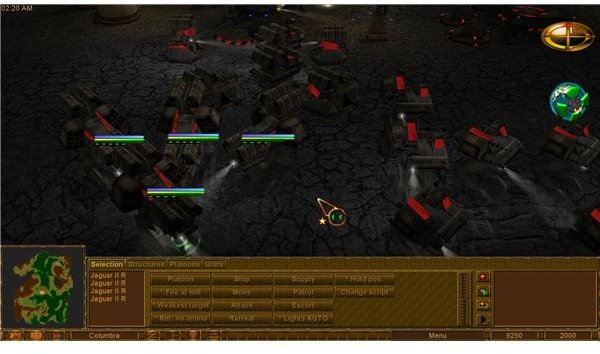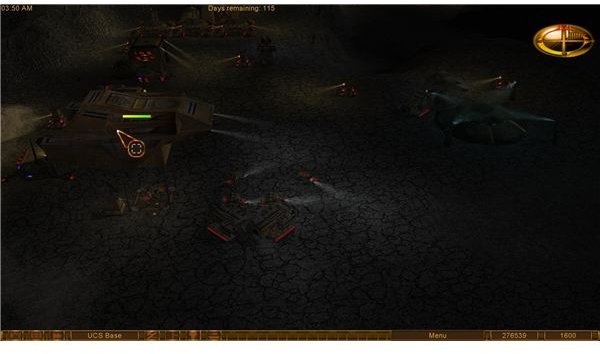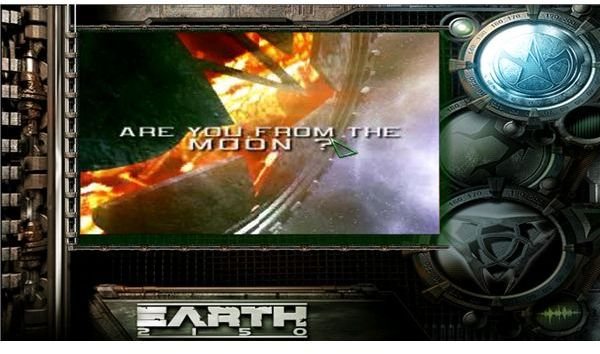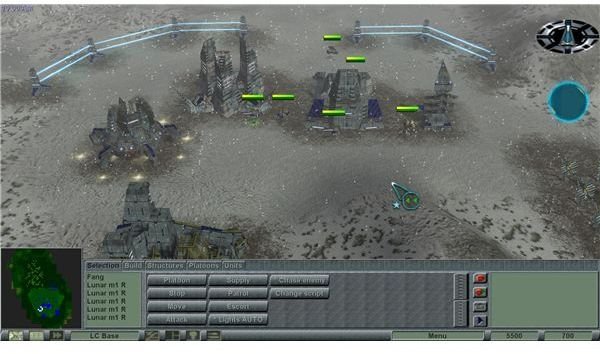Earth 2150: End of the Earth and Escaping the Dying Planet

Earth 2150: Escape From the Blue Planet for PC
The Earth 2150 Trilogy (the base game and its two expansion packs) was a fairly unique real time strategy title when it was released in 2000. Developed by a Polish company, Earth 2150 was one of the first games to be shipped to have 3D terrain, and integrated significantly different gameplay dynamics relative to most previous RTS titles. Of these, the biggest standouts are the diversification of the factions within the game, the ability to carry units over from mission to mission, and a goal that had to be met prior to the end of the game’s time limit if victory was to be won.
Earth 2150 technical controls when it came to unit design and management were another area of innovation. Units could effectively gain experience and level up, but this was not the only aspect more common to turn based strategy games found in the Earth 2150 trilogy. Players were actually allowed to customize the weapons loadout on the various vehicle and aircraft bodies made available through research, allowing a high degree of flexibility in what units could be brought to the battlefield and how they could best be deployed. Units could also be assigned highly selective behavior scripts that would govern their movement, combat behavior and mobility.
Compared to the previous generation of real time strategy games, like Starcraft, and even titles released years later, like Command and Conquer Generals, Earth 2150 demonstrated an admirable level of ingenuity on the part of the developer. The mechanics were solid, the AI was decent and the customizability ensured replayability.
The State of the Earth in 2150
The backstory to Earth 2150 is fairly deep - like Homeworld and other games of this period in real time strategy development - Earth 2150 provided significant detail into the factions and their particular histories. Years before, the world was largely annihilated in a nuclear conflict. Two governments emerged from the ashes.

The United Civilized States (UCS) were composed of more than a dozen of the largest of the states in North America and survived due to heavy investment in anti-missile defenses prior to the war. The survivors were technologically advanced compared to the rest of the burned out ruins of human civilization, and began constructing robots to do their thinking and work in the long run.
The Eurasian Dynasty (ED) emerged from the steppes of Central Asia after the radioactive fallout from the war had largely blown away. Made up of military units, their families, and other survivors, the ED sent scouts into the steppes and found that survivors had returned to a nomadic, herding lifestyle. They used their knowledge of pre-war technology to become the leaders of these survivors, and formed a new government called the Khanate. The Khans of the Eurasian Dynasty spread their control over the ruins of Europe and Asia and forged a new empire dedicated to rebuilding human civilization.
Of course, there was a third faction - just not one that lived on the Earth. By the time of the nuclear holocaust and the end of the Earth as it had been, a corporation had established a colony on the moon. Having survived the war, the Lunar Corporation (LC) colony was in a position to advance its technology and culture independent of the destroyed home planet. It evolved into a matriarchy with high tech equipment, and long remained out of touch with Earth.
2150 and the End of the Earth
The Eurasian Dynasty and United Civilized States never got on too well, and in one of their many wars a salvo of nuclear missiles was launched into armies battling around the North Pole with warheads so powerful that they knocked the planet out of its normal orbit. Years later, Earth’s orbit is decaying to the point that it will soon be rendered uninhabitable by the Sun’s heat, and both factions now seek a way to save themselves by colonizing Mars. They begin a new war, and when the Lunar Corporation figures out what is happening to the Earth and its satellite (unfortunately locked in Earth’s gravitational pull) a three-way brawl begins to gather up the dwindling remains of Earth’s natural resources in order to support an evacuation to Mars.

The end of the Earth is only 180 days away when the player begins a campaign in the game, and the succeeding missions take place in an atmosphere of a rapidly changing climate and increasingly desperate conflict over the few patches of valuable resources left. The game is structured so that one or more missions are available at once, and once all are completed a new set will become available - usually accompanied by a shift in the climate. The 180 day clock is running throughout the course of the game, so this is not a title where wandering away for a few hours or exploring every inch of every map will necessarily be wise. During these missions, research can be done and new designs constructed, but a key component of any game of Earth 2150 must be discussed: dual bases.
Multiple Bases in Earth 2150
Unlike most real time strategy games, Earth 2150 allows the player to carry units over from one mission to the next, so long as they are present in the player’s main base when the mission ends. The main base for each faction is actually never under threat of enemy attack - it is located deep in the faction’s controlled territory and serves as a unit marshaling point and research center. Missions take place somewhere else in the world, and are connected to the main base by a huge aerial transport vehicle that is tied to a buildable landing beacon. One of these will be present or can be built in most missions, and this allows units loaded into the transport to be shipped between the main base and the mission base.
This entire mechanic is clever and even tracks with the real world, where construction and research activities are often done far from the front, and combatants are shipped in and out. The main base is the hub of the game and allows the player to store resources between missions as well. This becomes vital as resources can be taken out of this “bank” to fund new unit construction, but also must eventually be given to the evacuation project in order to beat the game.
Earth 2150 takes on a highly realistic feel. Missions involve going out and getting resources or stopping an opponent from getting them, while carefully managing one’s own supply. It also provides a large scale, mission with an independent possibility of ultimate failure: if you burn up too many resources fighting the enemy and rebuilding lost units it is possible to not have enough to fund the evacuation project by the time the last mission is complete! Needless to say, if your faction is still Earthbound when the end of the Earth comes, you lose.
Earth 2150 Factions and Unit Innovations
Aside from being one of the first games to incorporate full 3D technology and controls, thus allowing for zooming and rotating the camera, Earth 2150 is special due to its differentiated factions and unit controls.
Unit bodies can be researched and then entered into a unit database, where they can be given weapons that range from tank cannons and grenade launchers to plasma cannons and rockets. Custom designs allow for a wide variety of units so that even if an army is composed entirely of one chassis it may have units capable of completely different missions. The ability to set units to follow very particular behavioral scripts means that they can be controlled in combat to an extreme degree, and this opens up the door to all kinds of new strategies.
The UCS faction is reliant upon robotic technology - mechs and drones - and at the start of the game it is perhaps far too reliant on robots for its own good. Their initial weapons are only ballistic grenade launchers and machine guns, and while the former are powerful they are also unable to hit a moving target with any efficiency. Their break comes when plasma weapons are researched, which alongside heavy guided rockets can take a powerful toll on any opposing force that dares to come near.
The ED faction utilizes old-school technology, including tanks and helicopters. Although these might seem weak in comparison to the mechs operated by the UCS, don’t underestimate the ED. Their tank guns are better at aiming than UCS grenade launchers and pose a threat even when the UCS gets plasma weapons. Better yet, the ED is able to develop laser technology which can overheat unshielded enemy units and blow them apart in seconds. It also gains guided rockets and heavier cannons - and also wields nuclear weapons in the endgame.

The LC is a difficult faction to get used to because its vehicles are heavily shielded but also very weak. They use hovering vehicles armed with exotic energy weapons that fire bolts of electricity or waves of sound to damage opponents. While LC units are delicate, they pack a punch. The LC even has an advantage in one sense, in that its power requirements are met by collecting solar energy, but excess is stored in batteries for use during the night. Even destroying LC solar panels won’t immediately cripple the LC base.
Earth 2150 and Escaping the Planet

If resources are gathered appropriately and missions do not devolve into painful slugging matches, it is possible to achieve victory in Earth 2150. Technically, it is feasible to win long before the deadline, but it takes a brave/lucky player to pull it off. More likely, the resource collection effort will go down to the wire.
The end of the Earth isn’t pretty. Although the game begins in the grip of a nuclear winter that has brought snow and ice to most of the temperate regions of the world, the decaying orbit means that the snow quickly melts. This results in a short period of rebirth for Earth’s foliage, as plants take in the sunlight and warmth that comes with the end of the long winter. But this phase doesn’t last: warming continues, and the oceans begin to dry up. Sea levels rise, then drop, as water evaporates in the increasingly harsh heat. Soon the Earth is nearly dry, and the factions battle over resources located on what used to be the sea floor. And then, in the last month of Earth, gravitational forces begin to rend the planet asunder. The last war on Earth is fought alongside rivers of molten magma and under darkened volcanic skies.
If you are successful in pulling out the resources required, your faction will escape the dying planet. If not, it’s time to start the campaign over again. A few tips will help new gamers avoid this ignominious end: don’t get caught up in slugging matches during the missions, do all you can to keep experienced units alive, and send as many resources directly to the spaceport in the main base as possible.
If you are more than two-thirds of the way to your goal of one million credits by the time the planet starts to look like a volcanic wasteland, you ought to be fine so long as you husband your resources and don’t build too many units. The last missions involve exploiting newly exposed resource fields which have hundreds of thousands of credits worth of materials. Of course, controlling them won’t be easy…
References and Image Credits
A Brief Overview of SSI at MobyGames
The Earth 2150 User Manual and Campaign
All images screenshots of Earth 2150 created by Andrew Tanner
